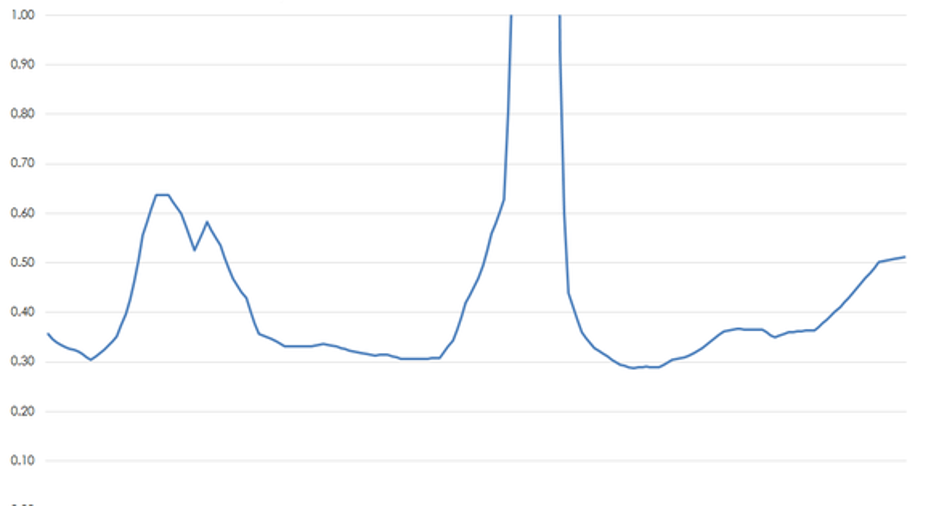The Most Important Dividend Stock Chart You'll Ever See

Image source: Getty Images.
Pour one out for dividend growth. It had a great run.
If you haven't noticed, many dividend growth stocks are growing their dividends only superficially. Some so-called dividend aristocrats, a group that includes companies that have increased their distributions for 25 years in a row, are increasing payouts at a snail's pace. Consolidated Edison (NYSE: ED), AT&T (NYSE: T), and Sysco (NYSE: SYY) grew their dividends in 2016, but the largest increase was Sysco's at just 3.3%.
It's part of a larger trend. Dividend growth is slowing broadly. This June, dividend growth among S&P 500 components slowed to 6.5% year over year. It was the smallest increase since March 2011, which marked the starting point of one of the greatest runs in increased payouts to shareholders.
While there is no perfect way to measure the sustainability of dividend policies, many observers look to the tried and true dividend payout ratio, which is calculated by dividing dividends paid out by a company's net income. A company that pays out $3 billion of dividends on $10 billion of net income would have a dividend payout ratio of 30%.
Over the short term, companies can reward shareholders with dividend growth by simply paying out a greater proportion of earnings. Eventually, however, a company will find its limit, and meaningful dividend growth will have to follow meaningful earnings growth.
This chart illustrates exactly what I mean. S&P 500 stocks are paying out more than 50% of their combined earnings this year. The median company paid out 39.5% in the second quarter, according to a FactSetreport. Both of these figures are well above average since the turn of the century and are more representative of recessionary payout ratios, which are temporarily inflated by deflated earnings.
It's not just one sector responsible for the rise in payout ratios, either. Nine out of 10 sectors in the S&P 500 are paying out more than their median payout over the last 10 years. Only telecom stocks are paying out less as a percentage of their income, though they still have the third-highest payout ratio of the 10 sectors that make up the S&P 500.
The free lunch is over
Starting from a low base during the financial crisis, it was only logical that dividends would increase at an elevated pace, as earnings recovered sharply, share repurchases were reduced, and companies were rewarded for paying bigger dividends. Eight years removed from the financial crisis, dividend growth is finding its most important limit -- earnings growth -- once again.
The post-crisis boom in dividends is something of a historical anomaly, but many dividend investors have only been around for years of robust dividend growth. If you find yourself in a room full of dividend growth investors, look around. If the meeting were held in 2006, 90% of the people you see might not be in attendance. (Dividend aristocrats are 10 times more popular today than they were just a decade ago, based on Google data.)
This isn't to say that every dividend-paying company will stop growing its dividend, nor is it to say that a focus on dividends has been unfounded. I understand why many investors want yield from their stock portfolios. Furthermore, I can't argue with the fact that dividend-paying companies have outperformed non-dividend-paying companies over very long periods of time, and done so with less volatility, the holy grail in investing.
But where finding dividend growth stocks was like shooting a fish in a barrel in 2011, the dividend growth investor of the future will need to be a little more discriminating. For large-cap stocks as a whole, the biggest dividend increases are very likely to be in the rearview mirror.
Forget the 2016 Election: 10 stocks we like better than AT and T Donald Trump was just elected president, and volatility is up. But here's why you should ignore the election:
Investing geniuses Tom and David Gardner have spent a long time beating the market no matter who's in the White House. In fact, the newsletter they have run for over a decade, Motley Fool Stock Advisor, has tripled the market.*
David and Tom just revealed what they believe are the ten best stocks for investors to buy right now... and AT and T wasn't one of them! That's right -- they think these 10 stocks are even better buys.
Click here to learn about these picks!
*Stock Advisor returns as of November 7, 2016
Jordan Wathen has no position in any stocks mentioned. The Motley Fool owns shares of and recommends FactSet Research Systems. Try any of our Foolish newsletter services free for 30 days. We Fools may not all hold the same opinions, but we all believe that considering a diverse range of insights makes us better investors. The Motley Fool has a disclosure policy.